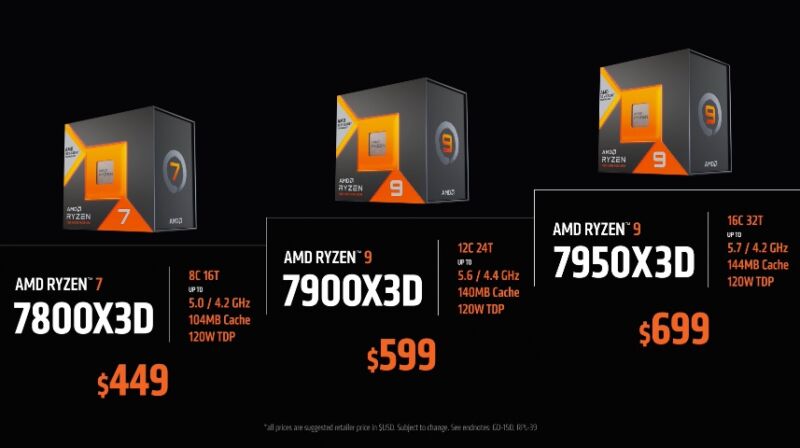
AMD’s pumped-up, 3D V-Cache-equipped Ryzen 7000 desktop processors will be available to buy on February 28, the company announced today. The rollout will start with the 12-core Ryzen 9 7900X3D and the 16-core Ryzen 9 7950X3D, which will start at $599 and $699, respectively. A cheaper model, the eight-core Ryzen 7 7800X3D, will be available for $449 but won’t launch until April 6.
All of these CPUs are successors to the original Ryzen 7 5800X3D, and their sales pitch is similar. AMD is stacking 64MB of additional L3 cache on top of the regular Ryzen 7000 CPUs, which can provide a big performance bump for software (like games) that is especially sensitive to cache sizes and speeds.
These prices are actually not all that much higher than the launch prices for the original Ryzen 7000 CPUs back in August—the 7950X3D has the same launch price as the 7950X, and the 7900X3D and 7800X3D are only $50 more expensive than their counterparts. But prices have come down a lot since then; the 7950X usually costs between $550 and $600 now, and non-X-series CPUs like the Ryzen 7 7700 and Ryzen 9 7950 are even cheaper. The X3D chips’ prices will eventually come down, too, but they’re still significantly more expensive than the versions without the extra cache.
It looks like AMD fixed some of the limitations that the original 5800X3D had when it came out. Most notably, there are now 12- and 16-core options for people who use their PC for things other than gaming. The X3D series CPUs still run at lower clock speeds than comparable X-series CPUs, but the gap is a bit smaller. And the CPUs support some limited performance tuning via the Precision Boost Overdrive and Curve Optimizer features, in addition to memory overclocking.
But the X3D chips still don’t support typical overclocking features available in the rest of the Ryzen CPUs, nor do they support changing the CPUs’ default 120 W TDP limits. This may further limit the performance of the 12- and 16-core CPUs in apps that don’t care about cache—the 7900X and 7950X have a default TDP of 170 W, which lets them run faster for longer. The Ryzen 5800X3D also ran hotter than other Ryzen CPUs, but Ryzen 7000’s baseline temperatures are already fairly toasty, so we’ll need to test them to compare.
AMD says the new CPUs will require a socket AM5 motherboard with an updated BIOS and chipset driver, and the company also “recommend[s] using at least a 280mm all-in-one liquid cooler for the best performance.”
Listing image by AMD